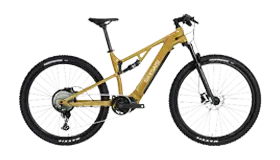The Regulation of Mountain Ebikes
In recent years, the popularity of mountain ebikes has surged, leading to an increased need for regulations to ensure the safety of riders and other trail users. As the technology and capabilities of ebikes continue to evolve, it is crucial for governing bodies to establish clear guidelines for their use on mountain trails.

Understanding the Classification of Ebikes
Before delving into the regulations surrounding mountain ebikes, it is important to understand the classification of ebikes. In general, ebikes are categorized into three classes based on their level of motor assistance and maximum speed. Class 1 ebikes provide assistance only when the rider is pedaling and have a maximum speed of 20 mph. Class 2 ebikes are equipped with a throttle that can propel the bike without pedaling, also with a maximum speed of 20 mph. Class 3 ebikes offer assistance only when the rider is pedaling and have a maximum speed of 28 mph.
Regulations for Mountain Ebikes
When it comes to mountain ebikes, regulations can vary significantly depending on the location and governing body. However, there are several common considerations that are typically addressed in regulations for mountain ebikes.
Trail Access: One of the primary concerns surrounding mountain ebikes is their impact on trail access. Many traditional mountain bike trails have restrictions or outright bans on motorized vehicles, including ebikes. It is essential for governing bodies to clearly define where mountain ebikes are permitted to ensure the preservation of non-motorized trails while also providing opportunities for ebike riders.
Speed Limitations: Another key aspect of regulating mountain ebikes is establishing speed limitations. Given the capabilities of ebikes to reach higher speeds with motor assistance, it is important to set appropriate speed limits to maintain safety on shared trails. This may involve differentiating between classes of ebikes and designating specific trails for each class based on their speed capabilities.
Environmental Impact: The use of mountain ebikes can raise concerns about their potential impact on the environment and natural habitats. Regulations should address measures to minimize erosion, protect wildlife, and preserve the ecological integrity of trail systems. This may include restrictions on certain types of terrain or seasonal limitations to mitigate environmental damage.
User Education and Etiquette: Effective regulations for mountain ebikes should also encompass user education and trail etiquette. Providing guidance on responsible riding practices, yielding to other trail users, and minimizing disturbances to wildlife can help foster a positive and respectful trail culture among ebike riders.
Enforcement and Compliance: Establishing regulations is only part of the equation; enforcement and compliance are equally critical. This may involve designated patrols, signage, and outreach efforts to ensure that riders are aware of and adhere to the regulations governing mountain ebikes.
Collaboration with Stakeholders: Given the diverse interests and perspectives within the outdoor recreation community, it is essential for governing bodies to engage with stakeholders including trail advocacy groups, environmental organizations, land managers, and local communities. Collaborative efforts can lead to more informed and inclusive regulations that balance the needs of various user groups and protect natural resources.
The Future of Mountain Ebike Regulations
As the popularity of mountain ebikes continues to grow, the need for comprehensive and adaptive regulations will become increasingly important. The evolution of technology and the expanding interest in outdoor recreation present ongoing challenges and opportunities for governing bodies to refine and update regulations to reflect changing circumstances.
Looking ahead, it will be crucial for governing bodies to stay abreast of advancements in ebike technology, monitor the impact of ebike use on trails and natural areas, and engage in ongoing dialogue with stakeholders to ensure that regulations remain effective and relevant.
In conclusion, the regulation of mountain ebikes is a complex and evolving endeavor that requires careful consideration of trail access, speed limitations, environmental impact, user education, enforcement, compliance, and collaboration with stakeholders. By addressing these key aspects, governing bodies can establish regulations that promote safety, sustainability, and positive trail experiences for all users.










